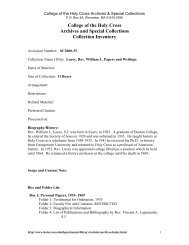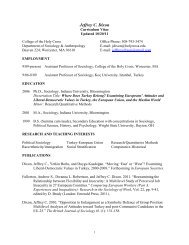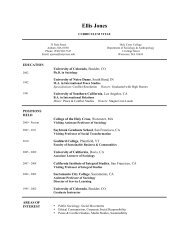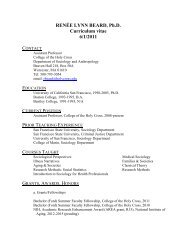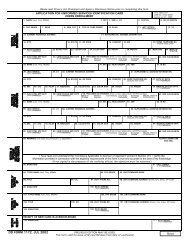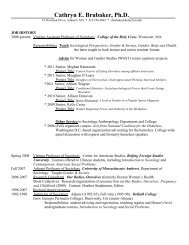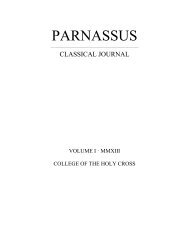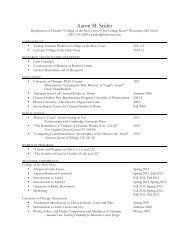Control of frequency in cricket song - The Journal of Experimental ...
Control of frequency in cricket song - The Journal of Experimental ...
Control of frequency in cricket song - The Journal of Experimental ...
Create successful ePaper yourself
Turn your PDF publications into a flip-book with our unique Google optimized e-Paper software.
Sound pressure level (dB)<br />
-20<br />
-40<br />
-60<br />
-80<br />
-20<br />
-40<br />
-60<br />
-80<br />
A<br />
Air<br />
4.6 4.8 4.9536 5.0<br />
5.2<br />
B<br />
Helium-air<br />
4.6 4.8 4.9508 5.0 5.2<br />
Frequency (kHz)<br />
Fig. 3. Record<strong>in</strong>gs made <strong>in</strong> the chamber shown <strong>in</strong> Fig. 2 when filled<br />
with air (A) or approximately 100 % helium (B). A 5 kHz tone was<br />
played through a cone loudspeaker located <strong>in</strong>side the chamber,<br />
recorded us<strong>in</strong>g the chamber microphone and analyzed as for <strong>in</strong>sect<br />
calls (see Materials and methods). <strong>The</strong> spectra <strong>of</strong> the digitized<br />
signals showed no difference <strong>in</strong> peak <strong>frequency</strong> (vertical l<strong>in</strong>e) <strong>in</strong> air<br />
compared with helium. <strong>The</strong> approximately 50 Hz difference between<br />
the synthesized <strong>frequency</strong> (5 kHz) and the peak frequencies <strong>in</strong> both<br />
air and helium was due to a slight difference <strong>in</strong> the speeds <strong>of</strong> the tape<br />
recorders used to record and play the signal. This difference was<br />
repeatable when the same experiment was performed <strong>in</strong> the open<br />
laboratory. Spectra are referenced aga<strong>in</strong>st a 120 dB SPL re 20 μPa<br />
signal.<br />
Measurements made outside the chamber will suffer some<br />
excess attenuation, and it was not possible to achieve precise<br />
position<strong>in</strong>g <strong>of</strong> the microphone relative to the <strong>cricket</strong>.<br />
Nevertheless, experiments us<strong>in</strong>g a speaker <strong>in</strong> the chamber<br />
showed that this arrangement could reliably detect changes <strong>of</strong><br />
1–2 dB SPL re 20 μPa.<br />
Tegm<strong>in</strong>al free resonance<br />
To measure the free resonances <strong>of</strong> isolated w<strong>in</strong>gs <strong>in</strong> air and<br />
helium-air, we used apparatus and procedures similar to those<br />
<strong>of</strong> Nocke (1971) and Bennet-Clark (1987). We clipped the<br />
basal stalk <strong>of</strong> freshly isolated tegm<strong>in</strong>a from male Gryllus<br />
rubens to a flexible wire, put it <strong>in</strong> an <strong>in</strong>verted position (the w<strong>in</strong>g<br />
is curved), dusted it lightly with charred cork dust and<br />
positioned it over an exponential horn loudspeaker. <strong>The</strong> output<br />
<strong>of</strong> an audio signal generator (Leader Electronics, model LAG<br />
120B) was amplified by a Realistic SA-155 audio amplifier that<br />
<strong>in</strong> turn drove the horn loudspeaker. <strong>The</strong> harp could be observed<br />
with a low-power microscope. We placed microphones for<br />
monitor<strong>in</strong>g SPL and <strong>frequency</strong> near the w<strong>in</strong>g, and then<br />
<strong>Control</strong> <strong>of</strong> <strong>frequency</strong> <strong>in</strong> <strong>cricket</strong> <strong>song</strong><br />
589<br />
enclosed the entire apparatus except for the signal generator,<br />
amplifier and SPL meter <strong>in</strong> a plastic bag that was sealed with<br />
tape. <strong>The</strong> microscope objective entered the bag via a taped<br />
open<strong>in</strong>g.<br />
We <strong>in</strong>flated the bag with either compressed air or helium<br />
(which became ‘heli-air’ mixture s<strong>in</strong>ce the bags leaked) until<br />
it was nearly turgid. We calculated the degree to which the<br />
helium was diluted us<strong>in</strong>g the method described previously for<br />
the record<strong>in</strong>g chambers. At the time <strong>of</strong> the measurements,<br />
typical ‘heli-air’ mixtures were 75 % helium:25 % air. <strong>The</strong><br />
experimental sequence was air, heli-air and then air to establish<br />
that there were no changes to the harps dur<strong>in</strong>g the experiment.<br />
Experiments consisted <strong>of</strong> vary<strong>in</strong>g the <strong>frequency</strong> <strong>of</strong> applied<br />
sound while look<strong>in</strong>g for harp resonance which could be<br />
identified by movement <strong>of</strong> the cork dust on the vibrat<strong>in</strong>g harp.<br />
We ma<strong>in</strong>ta<strong>in</strong>ed constant SPL levels (with<strong>in</strong> ± a few tenths <strong>of</strong><br />
a decibel) regardless <strong>of</strong> driv<strong>in</strong>g <strong>frequency</strong>. We found the<br />
resonant <strong>frequency</strong> by record<strong>in</strong>g (and analyz<strong>in</strong>g as described<br />
below) a sample <strong>of</strong> the sound that produced the visually<br />
determ<strong>in</strong>ed maximum displacement <strong>of</strong> the cork dust.<br />
Collection and digitization <strong>of</strong> sounds<br />
We collected sounds us<strong>in</strong>g either the call<strong>in</strong>g chamber’s<br />
Electret microphone (Fig. 2) or, <strong>in</strong> the case <strong>of</strong> record<strong>in</strong>gs <strong>in</strong> the<br />
anechoic chamber (see below), an Azden ECZ-660 zoom<br />
microphone. In all cases, the microphones were attached to a<br />
Marantz PMD 201 cassette recorder us<strong>in</strong>g type II high-bias<br />
tape. We digitized the sounds us<strong>in</strong>g 16 bit, 44.1 or 48 kHz A/D<br />
converters. Nearly all the energy <strong>in</strong> our record<strong>in</strong>gs was at<br />
frequencies below 6 kHz. <strong>The</strong> signals lacked any significant<br />
energy near the Nyquist limit (22 or 24 kHz) so alias<strong>in</strong>g was<br />
not a problem.<br />
Analysis <strong>of</strong> sounds<br />
We analyzed sounds us<strong>in</strong>g Canary 1.2 sound-analysis<br />
s<strong>of</strong>tware (Cornell Laboratory <strong>of</strong> Ornithology, Ithaca, New<br />
York, USA) and a Mac<strong>in</strong>tosh computer. Spectra had a<br />
<strong>frequency</strong> resolution <strong>of</strong> approximately 22 Hz.<br />
Average carrier frequencies were determ<strong>in</strong>ed on the basis <strong>of</strong><br />
1–2 s <strong>of</strong> constant call<strong>in</strong>g (40–160 sound pulses, depend<strong>in</strong>g on<br />
the species and time). We also determ<strong>in</strong>ed the fC <strong>of</strong> <strong>in</strong>dividual<br />
sound pulses by isolat<strong>in</strong>g and plac<strong>in</strong>g them <strong>in</strong> a sound w<strong>in</strong>dow<br />
preceded and followed by 10 ms <strong>of</strong> silence. Inclusion <strong>of</strong> the<br />
silent periods avoided ‘end effects’ (<strong>frequency</strong> artifacts <strong>in</strong> the<br />
spectrum when the beg<strong>in</strong>n<strong>in</strong>g or end <strong>of</strong> the signal co<strong>in</strong>cides<br />
with the onset or cessation <strong>of</strong> sound). To check for <strong>in</strong>tra-pulse<br />
<strong>frequency</strong> modulation, we isolated calls as described above and<br />
used the s<strong>of</strong>tware’s spectrograph feature. S<strong>in</strong>ce we identified a<br />
decrease <strong>in</strong> <strong>frequency</strong> with time, we divided s<strong>in</strong>gle calls <strong>in</strong>to<br />
three equal parts, isolated each third as described above,<br />
determ<strong>in</strong>ed its average <strong>frequency</strong> and then tested the results for<br />
statistically significant differences.<br />
We verified our ability to detect <strong>frequency</strong> changes <strong>of</strong> the<br />
same magnitude as those we observed <strong>in</strong> our experiments by<br />
creat<strong>in</strong>g synthetic sounds with known spectral characteristics<br />
that resembled those measured from <strong>cricket</strong> <strong>song</strong>s. We played



